65+ Fascinating Digital Nomad Statistics [Most Up-To-Date Figures]
Being a digital nomad has always been trendy, but in 2022 this lifestyle is becoming more ubiquitous.
Since the pandemic hit, more and more people are working remotely and independent of location.
This gives them the opportunity to explore the best places travel destinations, even as they continue working.
Did you know there are 35 million digital nomads around the world?
Or that a majority of digital nomads make between $50 to $250 thousand per year?
Whether you’re interested in becoming a digital nomad or simply want to understand the community, below are more than 65 interesting statistics about it!
Sources: I’ve included the source for each stat. Head over to the bottom of this post for a round-up of all the sources I have used.
What is a digital nomad?
A digital nomad refers to someone who works online from different locations, adopting a nomadic lifestyle as they travel from one place to another.
How many digital nomads are there globally?
In 2021, there were approximately 35 million digital nomads globally.
MBO Partners recorded around 15.5 million digital nomads in 2021 the U.S. alone. This is a 112% increase from only 7.3 million in 2019.

What is the average age of a digital nomad?
The average age of a digital nomad is 32 years old.
Millennials make up 44% of digital nomads in the U.S.

Where are most digital nomads from?
More than half of digital nomads worldwide are from the United States.
How much does the average digital nomad make?
On average, a digital nomad makes $117,959 per year.
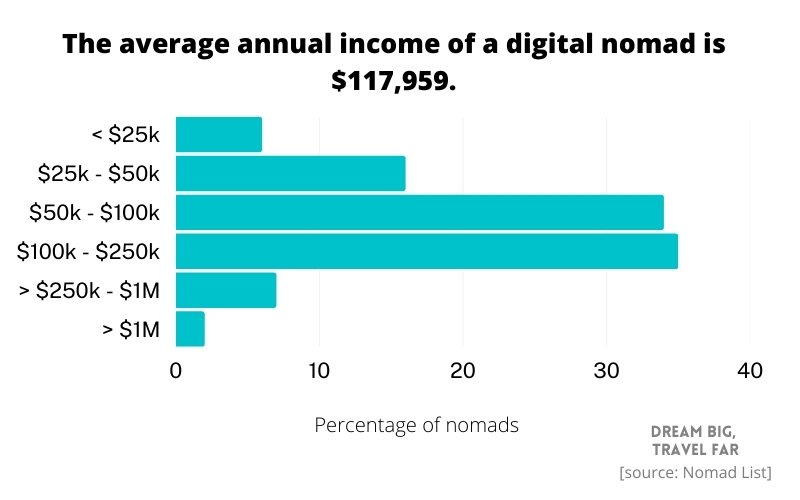
How many hours do digital nomads work?
The majority of digital nomads (70%) work 40 or fewer hours every week, while only 33% work over 40 hours.
Digital Nomad Statistics Summary
- In March 2022, over 50% of digital nomads worldwide are from the United States.
- Calculated from the total spending of digital nomads per year, they have a global economic value of around $787 million.
- In terms of travel jobs, most digital nomads work in information technology (19%), while the second most popular field is creative services (10%).
- Out of all self-employed digital nomads, 66% have their own business, while the other 34% are gig workers and freelancers.
- 55% of digital nomads worldwide hold a bachelor’s degree.
- Bangkok, Thailand is the top remote working city destination in 2021.
- In 2021, Lisbon was the most visited remote work hub by trip count.
- 46 countries around the world currently offer, or will soon offer, digital nomad visas.
- A study shows that remote workers tend to be 35-40% more productive than office workers.
- An overwhelming majority of digital nomads say they are highly satisfied (8%) or satisfied (%) with their work and lifestyle.
Who is the average digital nomad?
1. 80% of digital nomads are men, while 20% are women.
[Nomad List]
Only 1 in every 5 digital nomads are female.
2. The average age of a digital nomad is 32 years old.
[Nomad List]
3. Millennials make up 44% of digital nomads in the U.S., followed by 23% of Gen Xs and 21% of Gen Zs.
[MBO Partners]
Baby Boomers make up the smallest segment of the age group at 12%.
4. 56% of digital nomads claim to not be religious. 7% are Christians, while 2% believe in Buddhism.
[Nomad List]
5. In terms of ethnicity, around 3 out of every 5 digital nomads are white.
The majority of digital nomads (61%) are white, while 13% and 12% are of Asian and Latin heritage respectively.
[Nomad List]
6. 11% of male digital nomads report to be vegans, compared to 17% of female digital nomads.
[Nomad List]
Where are digital nomads from?
7. In March 2022, over 50% of digital nomads worldwide are from the United States.
[Statista]
8. The second most common nationality for digital nomads is British.
[Nomad List]
In addition to the US, a huge proportion of digital nomads across the world are from the UK.
9. 5% of the world’s digital nomads are Russians, while 4% are from Canada.
[Nomad List]
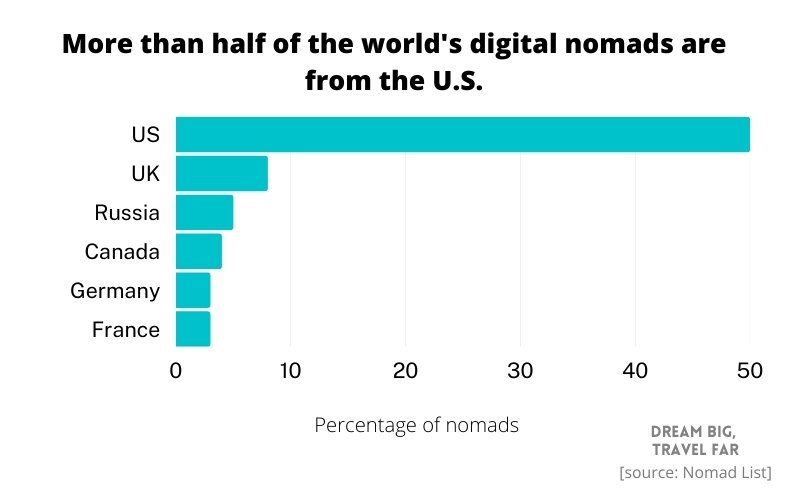
10. The number of digital nomads in the US doubled to around 15.5 million from 2019 to 2021.
[Statista]
This increase was partly driven by the Covid-19 pandemic as it encouraged remote working habits among most workers.
Digital nomad income and spending
How much does a digital nomad spend on average? How much do they make?
11. The average income for a digital nomad is $117,959 per year, while the median income is $85,000.
[Nomad List]
12. As of March 2022, most digital nomads earn between $50 to 250 thousand annually.
[Statista]
Less than 10% of digital nomads made less than $25 thousand per year.
13. 49% of digital nomads are employed full-time. 16% are startup founders, another 16% are freelancers, 7% are contractors, and 7% work in an agency.
[Nomad List]
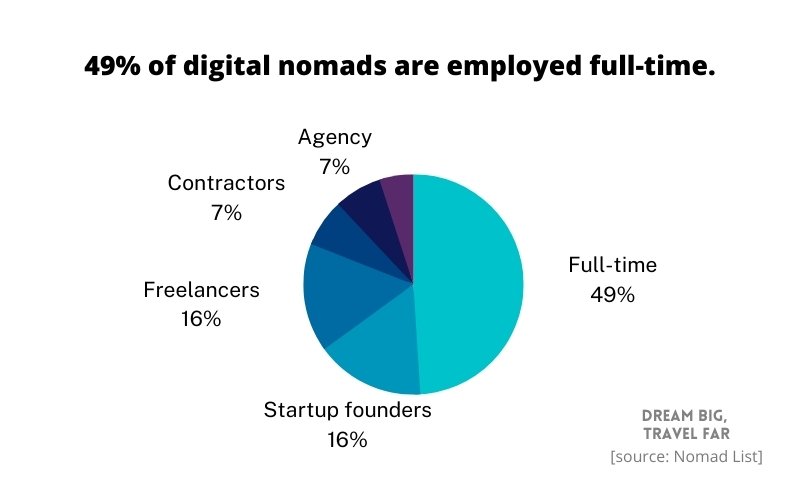
14. Around 4 out 5 digital nomad respondents say that they’re satisfied with their income.
[MBO Partners]
42% are very satisfied, while 37% are satisfied with their income. Regardless of their income, these percentages are slightly higher than a similar survey done among non-digital nomads.
15. Interviews reveal that digital nomads are usually satisfied with their income if the amount can support their travels.
[MBO Partners]
As long as they make enough to plan and book their travels, most digital nomads report to being satisfied with their income.
16. The average digital nomad has a $1,875 budget per month.
[ABrotherAbroad]
This adds up to a $22,500 annual budget. According to the report, the number is excluding savings and business expenses.
17. Calculated from the total spending of digital nomads per year, they have a global economic value of around $787 million.
[ABrotherAbroad]
Most popular digital nomad jobs
18. Most digital nomads work in information technology (19%), while the second most popular field is creative services (10%).
[MBO Partners]
Digital nomads can be found working in different fields, although most of them involve work that can be accomplished remotely over the Internet.
Creative services such as copywriting and videography or filmmaking are some of the best travel jobs out there.

19. 14% of digital nomads work in professions that aren’t usually associated with the remote working lifestyle, including architecture, medicine, law, and engineering.
[ABrotherAbroad]
A few other less common career paths include urban planner, mathematician, realtor, researcher, and psychologist.
20. Out of all self-employed digital nomads, 66% have their own business, while the other 34% are gig workers and freelancers.
[ABrotherAbroad]
Just as business travel is common in the corporate world, many self-employed digital nomads are also business owners.

21. The most common businesses owned by digital nomads are in e-commerce, coaching, agency, marketing, and translation services, in order of representation.
[ABrotherAbroad]
22. Digital nomads also own other types of businesses like photo editing, insurance, personal training, SEO, therapy, and human resources.
[ABrotherAbroad]
Photography and photo editing are some of the most common businesses owned by digital nomads, and these often include taking good travel photos.
23. 34% of male digital nomads work in software development.
[Nomad List]
This percentage is based on a survey conducted on tens of thousands of Nomad List members.
24. Among female digital nomads, the most popular jobs are in creative and marketing, with both taking up 18% of all respondents.
[Nomad List]
Digital nomad education
25. 55% of digital nomads worldwide hold a bachelor’s degree.
[Statista]
A March 2022 survey showed that most digital nomads have had higher education.
26. Around 33% has a Master's degree, and only 3% holds a PhD.
[Nomad List]
27. Digital nomads tend to be more tech-savvy than their non-nomad friends.
[MBO Partners]
77% of digital nomads say they use technology to become more competitive when working, compared to just 41% of the general population.
28. Out of all reported early adopters of technology, 76% are digital nomads.
[MBO Partners]
This is significantly more than non-nomads, who make up 36% of all early adopters of technology.
29. Specialized skills are important for digital nomads, with 64% claiming that their work requires special training, education, or expertise.
[MBO Partners]
On the other hand, 48% of non-digital nomads report to needing specialized expertise or training.
30. 68% of digital nomads have undergone work-related skills training in the past year, compared to 49% of non-nomads.
[MBO Partners]
Digital nomad destinations
31. Bangkok, Thailand is the top remote working city destination in 2021.
[Statista]
The best city destination for remote working is Bangkok in Thailand.
Different sources and ranking systems name different cities as the top destination, but the Holidu Index Score takes into account WiFi, availability of co-working spaces, coffee and food prices, transportation costs, climate, and tourist attractions.
32. As of March 2022, the United States was the most visited country by digital nomads. 15% of respondents report to having stayed there.
[Statista]
Keep in mind that a lot of digital nomads are American, which may affect this percentage.
33. In terms of the most visited city by digital nomads, London ranks first as 2.5% of respondents have stayed there.
[Statista]
34. Overall, Mexico, Thailand, Indonesia, Colombia, and Portugal are among the top rated countries for digital nomads worldwide.
[ABrotherAbroad]
35. 9 of the top 10 top locations for digital nomads are coastal countries.
[ABrotherAbroad]
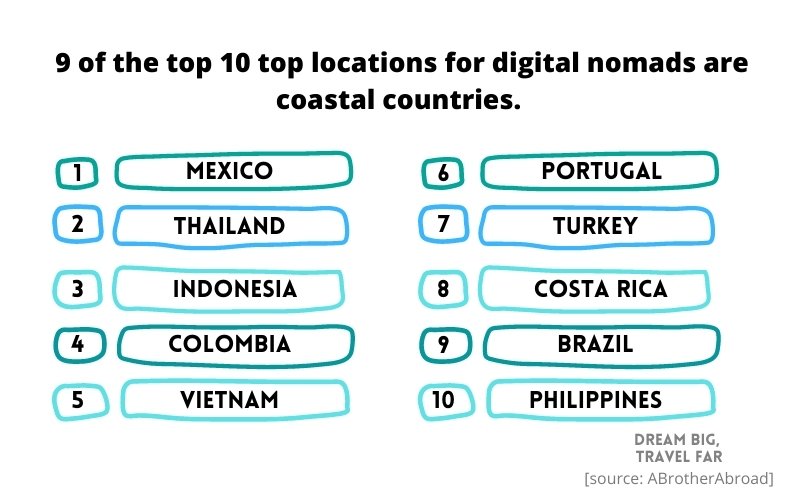
36. In 2021, Lisbon was the most visited remote work hub by trip count.
[Nomad List]
It’s followed by Mexico City, New York City, London, and Istanbul.
37. With a 254% growth from 2017 to 2021, Belgrade, Serbia is the fastest growing remote work hubs in the world.
[Nomad List]
This is followed by Tbilisi, Playa del Carmen, Kyiv, and Lisbon.
38. Whereas in 2022 alone, Singapore has proven to be the fastest growing remote work hub.
[Nomad List]
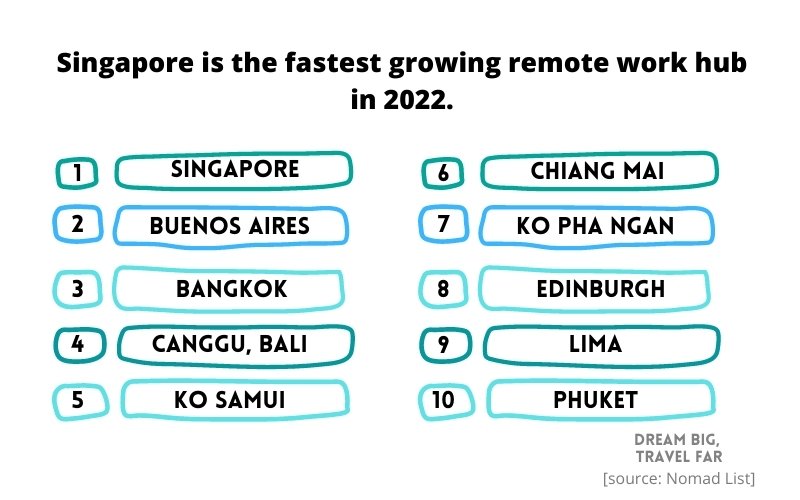
39. More than half of digital nomads (54%) stay between 7 and 30 days in one country.
[Nomad List]
29% stay for 30 to 90 days, 14% stay longer than 90 days, while only 4% of digital nomads stay for less than 7 days in one country.
40. As of September 2022, there are 46 countries offering digital nomad visas (including 7 programs in progress).
[TravelingLifestyle]
Of course, conditions and requirements will vary from country to country, and depending on where your passport is issued.
41. Germany is the country that grants the longest digital nomad visa validity (up to three years).
[Statista]
The average digital nomad lifestyle
42. The majority of digital nomads (70%) work 40 or fewer hours every week, while only 33% work over 40 hours.
[TheBrokeBackpacker]
43. 51% of digital nomads stay in hotels during their travels.
[TheBrokeBackpacker]
51% of digital nomads stay in hotels, while the next most popular accommodation is with friends and family (41%), followed by Airbnb (36%), vans (21%), and hostels (16%).
44. The most important factors when choosing a location for digital nomads are living costs and fast internet connection.
[Statista]
45. Following those reasons, safety is the next biggest factor for the digital nomad community when choosing a location to stay in.
[Statista]
46. A large majority of digital nomads like to work from their accommodation.
[Statista]
47. 20% of digital nomads like to work from a co-working space.
[Statista]
48. 4 out of every 5 digital nomads buy groceries and cook their own meals.
[TheBrokeBackpacker]
This is because eating out for every meal can quickly add up, while cooking will help you save money while on the road.
49. 53% of female digital nomads report to engage in hiking activities, compared to 50% of male digital nomads.
[Nomad List]
50. The second most popular sports among female digital nomads is yoga (49%), while the third is fitness (39%).
[Nomad List]
51. For male digital nomads, the second most popular sports is fitness (47%), while the third is running (30%).
[Nomad List]
Digital nomad and travel
52. Only 24% of digital nomads actually travel while working.
[Project Untethered]
Based on research by And.co, only 24% of people with a nomadic lifestyle actually work and travel at the same time.
53. Out of this 24%, 54% visit only 1 or 2 countries every year.
[Project Untethered]
This shows that the majority of digital nomads are actually not very mobile, preferring to stick in the same location for longer periods of time before moving elsewhere.
54. 29% visit 3-5 countries, while only 17% hit over five countries per year.
[Project Untethered]
55. 52% of American digital nomads plan to stay within the U.S., while the other 48% aim to travel internationally.
[MBO Partners]
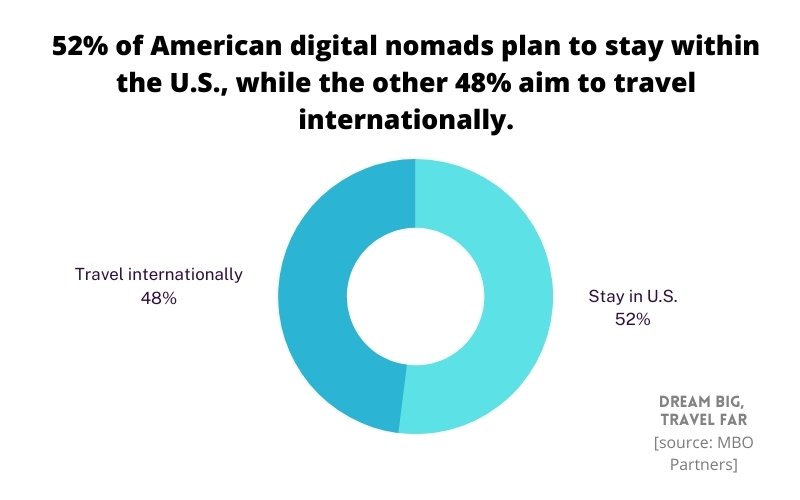
56. 35% of digital nomads who signed up on the Nomad List claim to be looking for friends, while 32% want to find travel buddies.
[Nomad List]
57. 16% of the members are actually looking to date casually, whereas 13% are looking for a relationship.
[Nomad List]
58. Half of all digital nomads currently traveling have been on the road for four years or less.
[ABrotherAbroad]
59. 30% of digital nomads have been traveling for more than 10 years.
[ABrotherAbroad]
On the other end of the spectrum, a portion of long-term nomads have been on the road for over a decade.
60. There are 2.6 million American VanLifers in 2021.
[MBO Partners]
In the US alone, around 2.6 million people travel and live in their RVs or converted vans. This figure is a 37% increase from 2020.
Productivity and work satisfaction
61. A study shows that remote workers tend to be 35-40% more productive than office workers.
[Global Workplace Analytics]
62. Another survey shows that 68% of respondents benefit from fewer interruptions when they work remotely.
[Flex Jobs]
63. In the same survey, 63% of remote workers say they enjoy a more focused time compared to when working from the office.
[Flex Jobs]
64. An overwhelming majority of digital nomads say they are highly satisfied (8%) or satisfied (%) with their work and lifestyle.
[MBO Partners]
Covid-19 impact on digital nomads
65. 19 million Americans in 2020 were reported to be aspiring digital nomads, compared to just 16 million in 2019.
[Statista]
Around 19 million U.S. citizens planned to be a digital nomad over the next 2 or 3 years, which rose by 3 million from the year before. Statista’s sources suggested that this trend was heavily influenced by the pandemic.
66. A quarter of company respondents claimed that at least 10% of their employees will continue working remotely post-COVID.
[Statista]
More and more traditional companies are offering the possibility of full remote positions, enabling more people to become digital nomads.
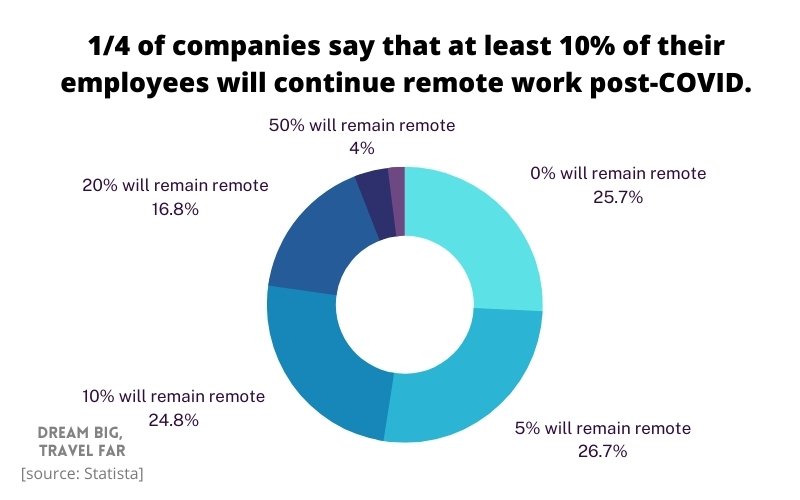
67. In June 2021, 42% of CIOs worldwide expected to be working in a hybrid model permanently.
[Statista]
68. In 2021, adult Americans who aren’t digital nomads were asked if they planned to be digital nomads over the next 2-3 years, 65 million answered yes or maybe.
[MBO Partners]
This is a 20% increase, as only 54 million responded with a yes or maybe in 2020.
Wrap-up
As physical location becomes a less important factor for companies and employees worldwide, it’s inevitable that more people will want to try the digital nomad lifestyle.
It has proven to be an effective way of working that makes us more appreciative of our careers and lives.
The digital nomad movement also shows how powerful the development of technology and the Internet has been that people can work together, no matter where they are in the world.
Did we miss anything important?
Let us know in the comments below!
Here’s a few other statistics you might be interested in…
Sources:



Leave a comment
Let us know what you think!